February 2024: Medicinal Plants of Crete
From the air, just before landing at Heraklion or Chania Airport, Crete may look somewhat dryish. Some spots are, but in many places there is plenty of water underground (read our previous blog, ‘Submerged Surprises, Feb. ’23, below). Therefore, vegetation of Crete is rich and varied.
Different growth areas
Changing air and sea currents around the island cause different weather conditions per region. Add to this the large height differences and very variable soil conditions, and it is understandable that you can discover many different growing areas, each with its characteristic plants and trees.
Countless medicinal plants among those. It is impossible to fully cover the hundreds of species in this story, so let’s limit ourselves to some wild medicinal plants that grow on our property! We have only partially cultivated the Galini Breeze plot, so it remains partly a fairly untouched hill with its natural vegetation.
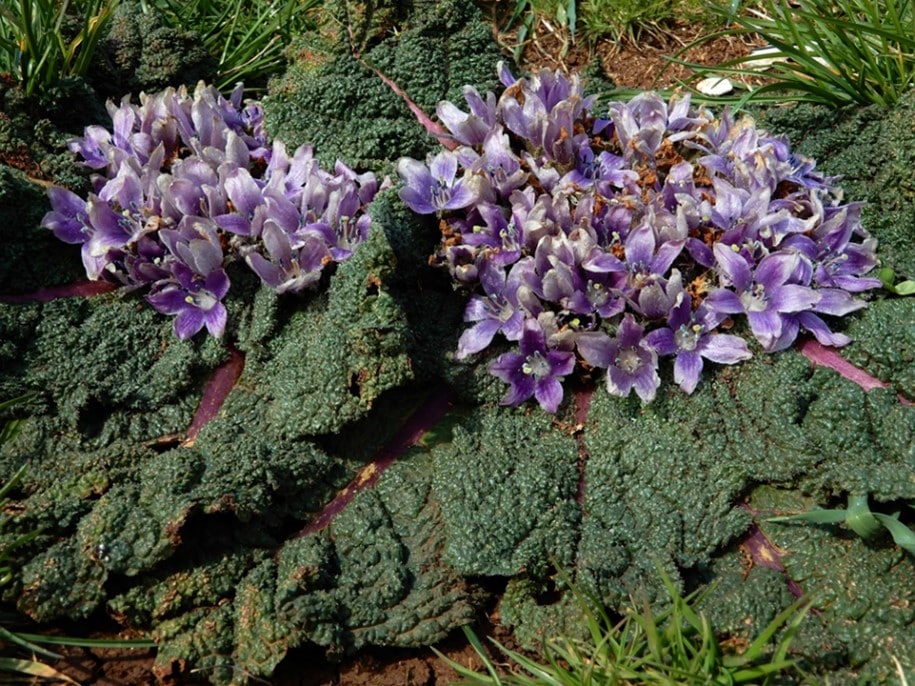
Hallucination with Mandrake
First, we encounter a fairly rare, but remarkable and eye-catching species: the Mandrake. It has been known for centuries that its berries and root are full of hallucinogenic substances. The shape of the root tuber often resembles a manikin, a kind of devil. In the Middle Ages there was a superstition that the plant could deadly scream when you pulled it out. Therefore, people used a dog or a silver spoon to harvest the root tuber. To be on the safe side, they still kept their ears closed, because you never know…! By the way, this plant also got its own scene in one of the Harry Potter films, you may remember?
We have never actually heard from the Greeks whether they also harvest the mandrake for its special juices – but rumors are that some expats collect the berries to sell or grow. We’d say: do not try this at home; don’t mess with Mandrake!
To the right: Mandrake in a 7th century handwritten copy of the famous medicine book ‘Materia Medica’ by Pedanios Dioskorides.
Dioskorides was a Greek physician, pharmacologist and botanist, who lived from approximately 40 to 90 AD. “The root often resembles a human,” it says.


Hippocrates advised Diktamos
Another characteristic medicinal plant that grows in many places on Crete, including here, is the Diktamos. Many beneficial properties are attributed to tea from this ‘Dittany of Crete’: good for love, digestion and circulation, helps against headaches, toothache and skin problems. Hippocrates (the Greek founder of Western medicine) wrote that the plant helps to stop bleeding and is used in wound care. Furthermore, the story goes that injured animals rub their wounds over Diktamos bushes for faster healing.
Spicy thyme against pain
Many medicinal plants bear striking pink or purple flowers. On our hill, for example, a certain type of Thyme. It smells wonderful and is used in countless Greek dishes because it gives a spicy, peppery taste. But it also has medicinal properties, such as an analgesic and calming effect on rheumatic pain. In scientific research, concentrated oil from this plant was found to have a more powerful antibacterial effect than many official health products.


Relaxing tea
Speaking of colors: in the spring there are weeks when the slopes of southern Crete turn bright yellow. That is a extraordinary, beautiful sight! This is due to masses of giant fennel with their green-yellow flower umbels, which tower high above fields full of ground-covering clover with small yellow flowers. Wild Chamomile also contributes to this beautiful play of colors in Spring. It has a relaxing effect and helps with insomnia. In addition, it is used as a disinfectant, anti-inflammatory and anti-allergic agent. You can also bleach your hair with it, but that is a completely different application! At many supermarkets and herbal shops you can get the native Chamomile in dried form to make tea, often mixed with other Cretan herbs such as Diktamos.
Shade and nutrients
Finally, a special plant; in this case not an herb but a tree. The majestic Carob Tree. We have about 15 of them, some planted along the access road, some small ones have sprouted spontaneously, and 4 big ones are already very old, with winding branches in an enormous dark green crown tens of meters in circumference. That’s also nice for some shade, for people and animals!
The seeds were previously ground and used as a thickener in baby food or for the production of surrogate chocolate. Medicinally, carob extract is used for digestive problems including diarrhea, heartburn and certain intestinal conditions such as celiac disease and thrush.
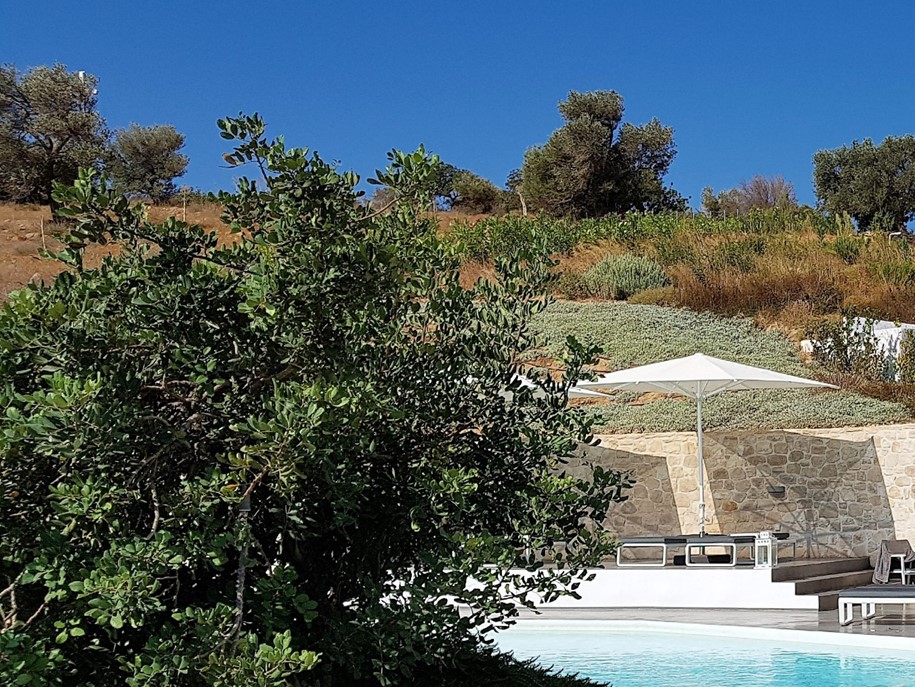
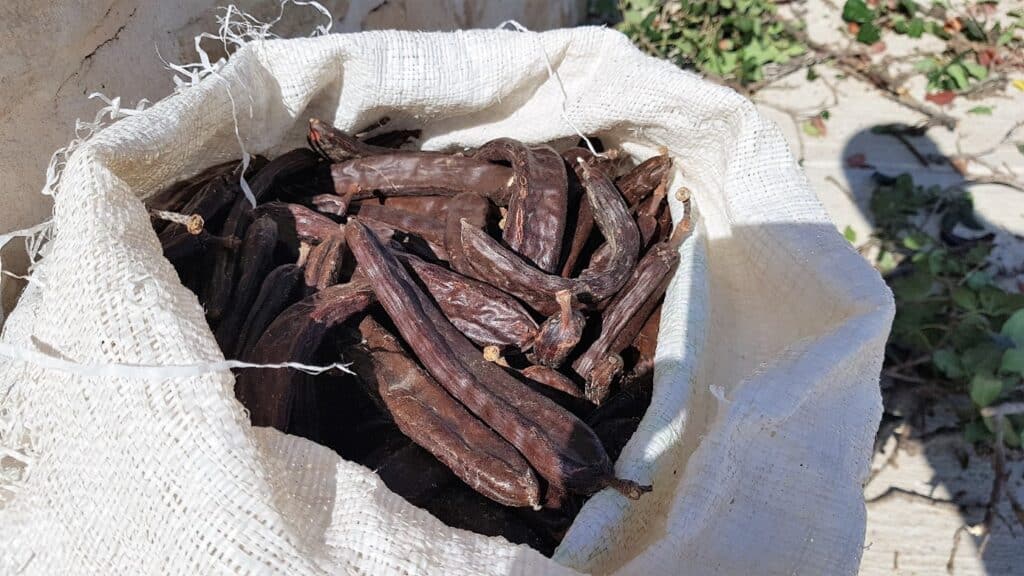
Carob food
With us, the pods still find a good destination: in the autumn an organic farmer from the neighboring village comes by to collect them as feed for his pigs. They are not so picky that they only want the kernel flour: they simply eat the whole pods. He once told us that a diet of carob pods is very healthy for his animals, and produces very tasty meat – a bit like Iberico ham, he even claimed! It’s great to use the bags full of fallen pods for this purpose, and it tidies up the garden nicely.
In short – on just a hill in southern Crete, you will already find a multitude of interesting medicinal plants! Some of these species still serve as basis for official medicines; others are mainly used in herbal teas, oven dishes or home-made tinctures. We just leave them, because they smell good and are a beautiful sight.
MH, Feb ’24
December 2023: Cretan music: authentic and unique
Lovers of Crete can enjoy its beaches, nature and antiquities, and certainly also the music.
Cretan music is known for its unique sound and atmosphere. The strong emotional and rhythmic charge arose during the time of the historical dominations by Greeks, Arabs, Turks and Italians on the island.
Many traditional songs are about historical heroic deeds, love, prosperity and adversity and are very recognizable. Traditional dances are often performed on it. There is the Pentozalis, a dance with high-jumping men, which can be seen as an expression of energy and strength.
The very rhythmic Syrtos is also beautiful; the girls and women of the village then dance very gracefully and proudly, at the village festivals such as Easter, Pentecost and the Ascension of Mary.
In the Kafenion
At any time of the year you can hear Cretan music; certainly not just on public holidays. When groups of friends sit in a Kafenion, the musical instruments are never far away.
In our village of Agia Galini, and its sister village in the mountains, Melambes, more and more young men are participating. That is very nice, as it shows that traditional music culture is definitely not disappearing.
Music lessons
The fact that traditional music is and remains an important part of social life in Agia Galini is partly due to Miro Papadogiannis. Miro is a celebrated musician who, in addition to his many performances throughout Greece, plays and sings about twice a week in the local music café of his uncle, Miron Tirokomakis throughout summer. He has been teaching music in the village for a few years now, and he knows how to inspire young and old for Cretan music.
So, I wanted to participate in that too! In the Netherlands I play in all kinds of bands, so I liked to get acquainted with these special chord progressions and rare time signatures of Cretan music too.
Well, that was easier said than done…
The Laouto is nothing like a guitar
I joined the teaching group, and borrowed one of the signature instruments in their music, the Cretan Lute (Laouto). It looks like a kind of 8-string guitar with a thick sound box. But the tuning of the strings does not simply run from low to high, like with a normal guitar. The 2nd string is tuned lower than the 1st, and then it goes up again with varying pitch spacings. That makes it sound very ‘Mediterranean’, but my knowledge of guitar chords was thrown straight into the trash…
Nine-quarter time
The time signatures in this music are also very special! Our Western music almost always has four beats (or three in the case of a waltz) per bar. However, the exciting and sometimes hypnotic Cretan music often has alternating blocks of two and three beats. Or one plays two beats of two and then three beats, or even 3 blocks of two and then one of three beats – hence a 9/4 time signature, for the experts.
That is of course much more varied than our standard time signatures, but it is difficult because you have to try to let go of your usual four-quarter time feeling.
Improvise and follow
In addition, the form of many songs is not predetermined. As soon as we started playing in a group, I noticed that the solo instrumentalist – usually also the singer – improvises during the song. He repeats important verses a few times, and his fellow musicians repeat that as if answering back. At the same time, he gives none or very subtle hints (cues) so that the rest of the company knows when the next chord comes, or when to move from a verse to the chorus or vice versa.
Authentic, with feeling
This ‘following each other’ makes the music very authentic, but it is extremely difficult for Western-educated musicians like myself to play along smoothly. “But Marcus, you feel those transitions automatically, don’t you?” Miro asked. Yes, maybe if you’ve heard that music since you were little, but no matter how hard I tried, it didn’t exactly come ‘naturally…’!
So after that rather hopeless year of lessons, I decided: as an ‘import musician’, I shouldn’t try to participate, but just enjoy the locals who play their Cretan music with so much natural feeling and energy!
Pop bands honor tradition
And if we wanted to hear something different from the typical, sometimes melancholy sounds of traditional Cretan music, we sometimes went to the bars along the beach to performances by live rock bands such as Alone Together, ZeroZero and Headlong. But for a complete introduction to contemporary Greek and Cretan music, the great Matala Beach Festival at the end of June is warmly recommended. The influence of the traditional styles is still clearly audible in many of the pop bands there. So, authentic Cretan music is still an important part of everyone’s cultural identity at the island!
Marc Hinfelaar
A group of friends from the village make music in the streets of Agia Galini. This was during the Κανταδα (‘Cantada’), August 6, 2021. This is the festive end of the national holiday Κοίμηση της Θεοτόκου (Kímisi tis Theotókou), “the Assumption of the Mother of God”, in commemoration of the Ascension of the Virgin Mary in body and soul. Local music and dance are of course part of this!
Blog, February 2023
South Coast of Crete: Submerged Surprises
The South coast of Crete around Galini Breeze is popular for great sunbathing and swimming. That’s obvious, because the sea is nice and the beaches and bays are super beautiful! But did you know there are submerged surprises too? Here are three stories of something special to see just below the waterline…
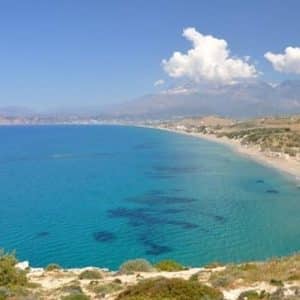
On the south side of Kommos Beach – a beautiful, kilometers-long sandy beach where dozens of nests of sea turtles can be found in summer – a rock protrudes from the water about 150 meters from the coast. It is clearly visible because the waves break there. Some bathers sometimes swim there, because snorkeling is great around the rock.
But…: it’s no ordinary rock at all!
It is the old harbour head of a sunken jetty from Minoan times. Right opposite that rock, excavations of a storage complex that once belonged to this port have been going on since Sir Arthur Evans started 1924. It is revealed that this was an important supply line for Faistos and Gortyn, the famous inland settlements in the Messara plain.
Few swimmers who lap around the rock nowadays, will realize that innumerable antique sailing ships from all over the Mediterranean unloaded their precious merchandise here, ages ago.
Matala, a little further away, is known for the caves in the chalk cliffs. Many visitors dream of the hippie days, when it was one big party in this area! But exactly on the other side of the bay, just below the waterline, there is something special too: storage basins for fish from the Roman era (around 200 AD).
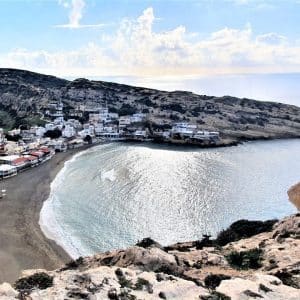
To keep caught fish alive and fresh, rectangular basins had been cut from the limestone coastal rocks just above the then waterline, which were continuously supplied with fresh water with an ingenious system of locks and gutters. One can still clearly distinguish some basins, but today those are just below seawater level. Even on aerial pictures those can be recognized. So, fish can now swim in and out freely!
A one-hour drive from Galini Breeze to the West, on Damnoni Beach near Plakias, a walk on the beach leads over strange round structures. A stone plateau with tiny waves of seawater gently rippling over it, contains perfectly round, shallow holes up to about a meter in diameter. A perfect habitat for sea anemones, crabs, sea urchins and all kinds of small fish. But of course, such a regular shape can never have arisen on its own, so what is it, you may ask?
It was a quarry.
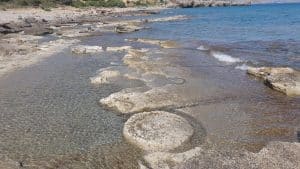
In ancient times, millstones were carved here, to grind grain in the watermills. Scattered (parts of) those millstones have been found in the region; consisting of exactly the same kind of material as found in this quarry. Apparently, this stone plateau provided an excellent quality of granite, to carve out the round millstones!
Finally, the question is: what causes these kinds of man-made structures to be located below the current seawater level? Has the island subsided in the past millennia, or has the sea level risen?
It is a combination of both, but the effect is not the same everywhere in Crete.
A good indicator are the Roman fish tanks as seen in Matala: similar structures have been discovered in a dozen places on Crete. Remarkably, they have sunken much deeper (up to more than four meters) under water in the East compared to the Central and West part of the island (at most 1.5 meters deep).
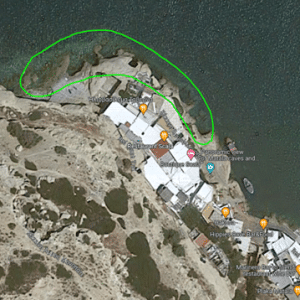
The explanation lies in the local dynamics of the earth.
On the one hand, the entire island drops very slowly and sea level on average rises a bit (until 1962; after it dropped in this area). Since the Venetian period (1600 AD), the net calculated effect of both movements is about 1.25 meters of relative subsidence.
But on the other hand, especially the Western half of Crete was lifted several meters in the past millennia by series of small and bigger earthquakes. Due to this movements, at Falasarna you can find a port from about 300 BC that is located about 6 meters above sea level on dry land now!
In short: the coastline of Crete is not just beautiful; it has an intriguing history too. So, let’s realize that the entire island and its inhabitants are never in a static, unchanging state, and society must always adapt to the everlasting dynamics of the earth.
Blog, November 2022
Freshwater Miracles of Crete
When people imagine Crete, they mostly envision year-round sunshine, perfect beaches, and the salty Cretan Sea surrounding Greece’s biggest island. In the island’s south, however, there are many miraculous freshwater phenomena to be found. These sources have a story and irreplaceable function too. Here are three examples that will enthrall you.
Kourtaliotis Waterfall
Kourtaliotis is a perpetual waterfall near Plakias. Strangely, almost miraculously, there is no river anywhere to be seen that supplies the vibrant falls. Instead, the cool mineral water – of very good and constant quality – apparently just emerges from some holes in a rocky wall.

Recently, Geologists discovered that the source is an overflow from an underground ‘aquifer’, or river. Each Winter, it seems, the aquifer collects the rainwater from a 105 km2 inland plateau, enclosed by hills on all sides. The water sinks into the porous limestone soil but then encounters a watertight rock layer at a depth of 150 to 350 meters.
A volume of no less than 43.4 million cubic meters of water is therefore locked up in a huge ‘underground tub’! This tub constantly overflows in just 2 spots, and the most important one is exactly at the feed of Kourtaliotis Waterfall. This continuous flowing water eventually winds its way to the river of the romantic palm beach of Preveli.
The Baths of Ancient Gortyn
Another very special freshwater phenomenon can be found at Gortyn, half an hour to the east of the tourist center of the South, Agia Galini. There, magnificent ruins of what once was the Minoan capital of southern Crete stand alongside remnants of the Roman Empire. The site has an amazing ancient citadel, palaces, bathhouses, fountains, and pleasure gardens. Once again, however, the source of all the freshwater that graced this paradise is not so obvious. A small river runs beside the ancient city, but it’s not nearly big enough to have supplied so much for the city, especially not in Summer.

As it turns out, the Romans found a water solution high up at Zaros, about Zaros, 15 kilometers away, on the flanks of the Psiloritis Mountains. Roman engineers and constructors built a canal system that transported approx. 7,000 m3 of fresh water per day to Gortyn. A 400m3 large reservoir was placed at the top to keep the pressure on. Another piece of engineering genius was an ‘inverted siphon’, halfway through the route. Without pumping, it simply guided the water via a closed aqueduct into a lower valley and up again over the next hill, and so on down to the citadel. Thanks to this reliable water supply, Gortyn was a good place to be in those days! And even today, the Zaros spring is the source of a famous bottled water brand with that name.
A Spili Wonder
The main road from Agia Galini to Rethymno runs past another beautiful place with hidden fresh water as a feature. At a small parking lot just before the village of Spili, today’s locals always stop to fill a few bottles or jerry cans with spring water under some lush trees. The quality is much better than the municipality water at home, they say.
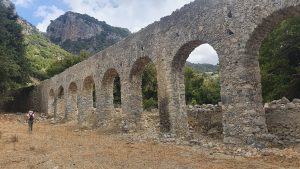
In previous times water from the spring flowed like a tiny river onto a beautiful arcade, which protruded into the valley at right angles. After about 150 meters, the arcade suddenly stops, and the waterfalls some 20 meters down through a kind of chimney. A dilapidated workshop can still be found there, where the force of the falling water is used to drive a millstone to grind flour for the local bakeries. Of course, a small chapel, Agia Fotia, overlooked this beautiful place, and hence that is the name of the source since ages.
Author’s note: You can reach these three places, Kourtaliotis Waterfall, Gortyn, and Spili, from Agia Galini in half an hour by car. Check www.visit-agiagalini.com for more information.
Blog: Freshwater Miracles of Crete
Publised in: https://www.argophilia.com/news/
Blog, July 2017
A one-way ticket to Agia Galini.
«Don’t dream your life – just live your dream»
When I meet Marc and Monique, they have just said goodbye to family and friends and they are left. This time not with a return ticket but with a one-way ticket. The village of Agia Galini in the South middle of the island of Crete is the final destination of this travel.
The couple has travelled half the world. In their younger years by the two of them, later with their two children, and in recent years together again. So they visited South Africa, Kenya, Tanzania, the United States and half of Europe. But, above all, Greece has been their most popular destination for decades.
The passion for Greece began early in their joint lives. About 30 years ago they took – adorned with Backpack – a plane ticket to Athens. In the port of Piraeus the youngsters took the first available ferry to one of the many Greek islands. Next morning, at sunrise they sailed into the caldera of Santorini. The unexpected spectacular views from the deck of the hundreds of meters high grey brown rocks, the snow-white villages balancing on the edge, the clear blue sky; that was a view they will never forget…
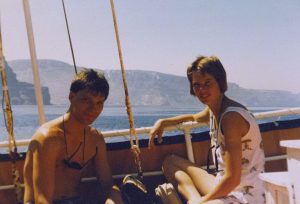
After this great trip they visited Greece year after year. They went to a new destinations every year, preferably to the somewhat lesser known islands and regions. “We skipped for example Kos and Rhodes, and selected mainly the lesser-known destinations like Koufonissia, Alonissos and Samothraki”, Monique explains. In all those years, they visited nearly 30 Islands, more than the average Greek.
The love for this nation and its inhabitants has been around ever since during that first trip, but deepened in the course of the time, as it were, into a solid marriage. Marc explains: “In fact, there are four aspects that are appealing to us in this country. To start, of course, the beautiful nature and the beautiful landscapes. Secondly – no surprise – sun guaranteed. Then there is the well-known hospitality of the Greeks”. He tells an exciting story, about a visit to a small village, were unfortunately no place for the night could be found. After the local inhabitants had provided them with food and drinks, and it became clear that shelter for the night was a problem, one of the villagers eventually offered his own house for the night. He and his family were o.k. to move to a small family-cod. “And maybe the most important, attractive aspect”, Monique fills, ”is the fourth element: the tendency of Greeks to live in the present moment, and the practical inventiveness in their way of living”.
That approach attracts Marc and Monique too. How organized and planned their own life and work in The Netherlands often may be, they closed the flexibility and convenience of the Greeks – the Greek joie de vivre – firmly in their hearts.
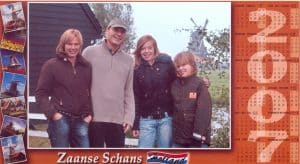
Twelve years ago, when during Summer holiday on the small island of Symi, they bought themselves a tiny writing booklet, to make notes about life every now and then. Short notes, loose phrases, spontaneous ideas. How do we see our future, what do we want to accomplish, where are we really happy? They carried that notebook with them for years, and steadily the blank pages got filled.
This so-called ‘book of dreams’ helped Marc and Monique over the years to ‘funnel’ their ideas, as they call this process themselves. During a stay at a small lodge in South Africa, everything seemed to fall into place. Running a small-scale accommodation, with a lot of privacy for the guests and heart-warming hospitality, that was what they wanted to create. Then created more specific plans and searched a long time for the best concept and place to achieve that dream. Florida, Amsterdam, South Africa: many options were considered until the compass eventually pointed to the South of Crete.
The choice for this particular village on this particular island in their beloved Greece features the couple: they seem to master the perfect combination of feel and ratio.
Monique tells: “During our exploration of the southern coast of Crete, we happened to stay in Agia Galini for some nights. Remarkably, at the entrance of the village a sign reads ‘Welcome Back Home’ and somehow it immediately felt like that. It is a beautiful place and it feels especially good. And, they fill each other: “the lovely authentic village is located by the sea, there are plenty of shops, there is a small fishing port, some 25 taverns, and Crete is fully equipped and easy to reach by daily low-cost flights from all European capitals. In short: a village from a booklet! And…: Crete has the longest season of all the Greek Islands. Obviously, in the end you’d better invest in a place where tourists can go 7 months a year, compared to an island where that is just 4 months.”
This couple links emotion and feeling to logical reasoning and common sense; that is what I noted during this interview..
Three and a half years ago they took the plunge. With the necessary legal assistance of Elxis, a real estate agency specialised in Greek real estate based in Utrecht, NL, they bought a large piece of land, just outside the village, with sea views. After an intensive search to select architects they assigned the reputable agency Action Constructing from Rethymnon to design and build this small scale holiday complex.

Construction from late 2015 until early 2017 went surprisingly smooth and now there are 4 studios for 2 persons each, there is a swimming pool, and a in addition a rentable villa in which they themselves will stay initially. The terraced complex is a wonderful amalgam between the cubist, minimalistic style of the Cyclades Islands, linked to the characteristic warmer Cretan building tradition with natural stone masonry chunks.
The studios (with the names Coast, Forest, Mountains and Sky, based on the 4 main Cretan ecosystems) are beautifully decorated, and equipped with all Western comforts and luxury. There is a beautiful swimming pool, but every studio also has a private shady terrace and private roof-deck.
Twice a week, they introduced the ‘Sundowner’ drinks, as they had enjoyed in Africa: just before dinner time a drink and some bites are offered in the common lounge by the pool. Guests can consult them for all possible questions, mingle and exchange their stories too. Excited Marc and Monique fill each other: tips about beautiful walks, interesting cities tours, wine tasting, cooking workshops and the way to the most beautiful remote beaches or excavations; guest will be helped with almost every conceivable desire.
I see the twinkle in their eyes. It is clear to me: in fact they want to offer their customers what they themselves liked the most during their holiday travels. Customization, attention, privacy and quality will be key in Galini Breeze.
And now the time’s finally come! Marc and Monique are anxious to get started. A few weeks after our interview, at the end of April ‘17, Galini Breeze has opened its doors.
They have kept their ‘dream booklet’. The dream that was created in bits and pieces while writing, is accomplished. But to be honest, I suspect that there are still a few blank pages in their booklet. I guess this couple it not yet fully done dreaming on.
Written by Frederiek Lommen
This article is published in ‘Griekenland Magazine’ (Greece Magazine), summer 2017.
http://www.griekenland-magazine.nl/
